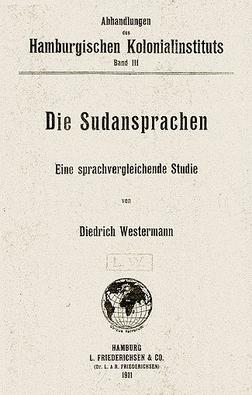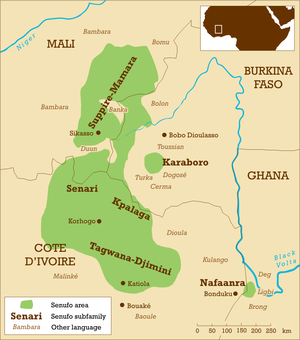
Dyula is a language of the Mande language family spoken mainly in Burkina Faso, Ivory Coast and Mali, and also in some other countries, including Ghana, Guinea and Guinea-Bissau. It is one of the Manding languages and is most closely related to Bambara, being mutually intelligible with Bambara as well as Malinke. It is a trade language in West Africa and is spoken by millions of people, either as a first or second language. Similar to the other Mande languages, it uses tones. It may be written in the Latin, Arabic or N'Ko scripts.

Niger–Congo is a hypothetical language family spoken over the majority of sub-Saharan Africa. It unites the Mande languages, the Atlantic–Congo languages, and possibly several smaller groups of languages that are difficult to classify. If valid, Niger–Congo would be the world's largest in terms of member languages, the third-largest in terms of speakers, and Africa's largest in terms of geographical area. Austronesian has almost as many member languages, although this is complicated by the ambiguity about what constitutes a distinct language; the number of named Niger–Congo languages listed by Ethnologue is 1,540.

The Gur languages, also known as Central Gur or Mabia, belong to the Niger–Congo languages. They are spoken in the Sahelian and savanna regions of West Africa, namely: in most areas of Burkina Faso, and in south-central Mali, northeastern Ivory Coast, the northern halves of Ghana and Togo, northwestern Benin, and southwestern Niger. A few Gur languages are spoken in Nigeria. Additionally, a single Gur language, Baatonum, is spoken in Benin and in the extreme northwest of Nigeria. Three other single Gur languages, the Tusya, Vyemo and Tiefo languages, are spoken in Burkina Faso. Another unclassified Gur language, Miyobe, is spoken in Benin and Togo. In addition, Kulango, Loma and Lorhon, are spoken in Ghana, Ivory Coast and Burkina Faso. Additionally, a few Mossi speakers are in Senegal, and speakers of the Dagaare language are also found in Cameroon. The Samu languages of Burkina Faso are Gur languages.

The Kwa languages, often specified as New Kwa, are a proposed but as-yet-undemonstrated family of languages spoken in the south-eastern part of Ivory Coast, across southern Ghana, and in central Togo. The Kwa family belongs to the Niger-Congo phylum. The name was introduced in 1895 by Gottlob Krause and derives from the word for 'people' (Kwa) in many of these languages, as illustrated by Akan names. This branch consists of around 50 different languages spoken by about 25 million people. Some of the largest Kwa languages are Ewe, Akan and Baule.

The Songhay, Songhai or Ayneha languages are a group of closely related languages/dialects centred on the middle stretches of the Niger River in the West African countries of Mali, Niger, Benin, Burkina Faso and Nigeria. In particular, they are spoken in the cities of Timbuktu, Djenné, Niamey, Gao, Tillaberi, Dosso, Parakou, Kandi, Natitingou, Djougou, Malanville, Gorom-Gorom, In-Gall and Tabelbala. They have been widely used as a lingua franca in that region ever since the era of the Songhai Empire. In Mali, the government has officially adopted the dialect of Gao as the dialect to be used as a medium of primary education.

The Mande languages are a family of languages spoken in several countries in West Africa by the Mandé peoples. They include Maninka (Malinke), Mandinka, Soninke, Bambara, Kpelle, Jula (Dioula), Bozo, Mende, Susu, and Vai. There are around 60 to 75 languages spoken by 30 to 40 million people, chiefly in Burkina Faso, Mali, Senegal, the Gambia, Guinea, Guinea-Bissau, Sierra Leone, Liberia, Ivory Coast and also in southern Mauritania, northern Ghana, northwestern Nigeria and northern Benin.

Nafaanra, also known as Nafanan or Nafana, is a Senufo language spoken in northwest Ghana, along the border with Ivory Coast, east of Bondoukou. It is spoken by approximately 90,000 people. Its speakers call themselves Nafana, but others call them Banda or Mfantera. Like other Senufo languages, Nafaanra is a tonal language. It is somewhat of an outlier in the Senufo language group, with the geographically-closest relatives, the Southern Senufo Tagwana–Djimini languages, approximately 200 kilometres (120 mi) to the west, on the other side of Comoé National Park.

Supyire, or Suppire, is a Senufo language spoken in the Sikasso Region of southeastern Mali and in adjoining regions of Ivory Coast. In their native language, the noun sùpyìré means both "the people" and "the language spoken by the people".

Mali is a multilingual country of about 21.9 million people. The languages spoken there reflect ancient settlement patterns, migrations, and its long history. Ethnologue counts more than 80 languages. Of these, Bambara, Bobo, Bozo, Dogon, Fula, Arabic, Kassonke, Maninke, Minyanka, Senufo, Songhay languages, Soninke and Tamasheq are official languages.
The Suppire–Mamara languages form the northern branch of the Senufo language family and are mainly spoken in Mali. They comprise five different languages, totalling approximately 750,000 speakers. The Northern Senufo languages are separated from the Central Senufo languages by a small band of Mande speaking people. To the east and west, they are also bordered mainly by Mande languages like Bambara and Dioula, and they have been influenced considerably by those languages in both vocabulary and grammar.

The Atlantic–Congo languages make up the largest demonstrated family of languages in Africa. They have characteristic noun class systems and form the core of the Niger–Congo family hypothesis. They comprise all of Niger–Congo apart from Mande, Dogon, Ijoid, Siamou, Kru, the Katla and Rashad languages, and perhaps some or all of the Ubangian languages. Hans Gunther Mukanovsky's "Western Nigritic" corresponded roughly to modern Atlantic–Congo.

In early 20th century classification of African languages, Sudanic was a generic term for languages spoken in the Sahel belt, from Ethiopia in the east to Senegal in the west.

The Senari languages form a central dialect cluster of the Senufo languages. They are spoken in northern Ivory Coast, southern Mali and southwest Burkina Faso by more than a million Senufo. Three varieties can be distinguished,
The Djimini people of Côte d’Ivoire belong to the larger Senoufo group. They have a population of about 100,000 and live in the north-eastern area of Côte d’Ivoire, in Burkina Faso and Mali.

Ghana is a multilingual country in which about eighty languages are spoken. Of these, English, which was inherited from the colonial era, is the official language and lingua franca. Of the languages indigenous to Ghana, Akan is the most widely spoken in the south. Dagbani, Dagare, Sisaala, Waale, and Gonja are among the most widely spoken in the northern part of the country.

Ivory Coast is a multilingual country with an estimated 69 languages currently spoken. The official language is French. This language is taught in schools and serves as a lingua franca in the country, along with Dioula.
The Gurma languages, also known as the West Mabia languages, form part of the Oti–Volta subgroup of the Gur languages. They are spoken in eastern Burkina Faso, northern Ghana, Togo and Benin and western Niger.
The Oti–Volta languages form a subgroup of the Gur languages, comprising about 30 languages of northern Ghana, Benin, and Burkina Faso spoken by twelve million people. The most populous language is Mooré, the national language of Burkina Faso, spoken by over 55% of Burkina Faso’s 20 million population and an additional 1 million in neighboring countries such as Ghana, Ivory Coast, Niger, and Mali.
Ega, also known as Egwa and Diès, is a West African language spoken in south-central Ivory Coast. It is of uncertain affiliation and has variously been classified as Kwa or an independent branch of Niger-Congo.
Miyobe or Soruba is an unclassified Niger-Congo language of Benin and Togo.














